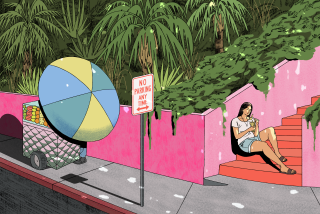Purple, gold and green -- once removed
I HAVE NEVER been to Mardi Gras in New Orleans. Both my parents are from there, and their families extend pretty far back; I suppose I never quite felt the need to go. Though an L.A. native, I grew up with plenty of stories about Mardi Gras and its endless festivities, colorful beads, boiled crayfish and nightly balls.
I knew all about the floats and parades, the joyous second-line dancing that was actually rooted in funerals, and the lavishly decorated umbrellas and handkerchiefs that went with them. Relatives who made a pilgrimage to Mardi Gras every year came back to Los Angeles and gave a report, not just on the event (that never changed) but on how the New Orleans branch of family and friends were doing: who was sick, who was recovered, who was putting up a new roof.
The connections were alive and humming, and always had been. Going to New Orleans to celebrate Mardi Gras would have been as necessary as an Irish American going to Dublin to celebrate St. Patrick’s Day, which is to say: not very. Dublin wasn’t going anywhere, and even if it did -- an impossibility, of course -- enough of it has found its way here to last a long while. As it happens, L.A. has the biggest population of Creole people outside of the Creole capital of New Orleans itself. Statistically speaking, we were safe.
But statistics can be deceiving, even imaginary. When New Orleans came apart last year during and after Katrina, when the relatives fled or died or lost it all in less than a week, L.A. teetered. It was suddenly cut off from a major artery, a chief supplier of the city’s lifeblood; we realized that, numbers notwithstanding, Los Angeles was merely New Orleans’ lively reflection, not its equal.
The transplanted population that had once lived in strong Creole enclaves such as Leimert Park already had left and moved on, part of the general black flight that forced central L.A. into a new age that is still unfolding. It’s not that Louisiana L.A. erased itself entirely. We kept going to the parties and gatherings, but they grew less regular and more seasonal; Mardi Gras became theater for which we all gathered to play our parts once a year. When it was over we gathered our beads and other remnants of our costumes and dispersed to our various neighborhoods, in true L.A. fashion.
This year, of course, Mardi Gras in New Orleans suddenly makes no sense. Here in L.A. too, it is different, more muted. I was thankful to go to my cousin Errol’s home in the Valley last weekend for a combination birthday and Mardi Gras party.
It was also an opportunity for the clan to gather and celebrate something else: Errol had suffered a debilitating stroke late last year and had made a remarkable, complete recovery. And it is Errol who has emerged over the last decade as the family’s most faithful keeper of Mardi Gras and all New Orleans traditions. He is a kind of self-appointed parade marshal, always turning up at weddings and parties with second-line regalia -- hat, whistle, fancy epaulets -- and music to dance by.
His party this year was lovely, the tables and walls festooned with Mardi Gras purple, gold and green. But it was distinctly un-raucous, with the emphasis less on fete and more on family and counting ranks. When we gathered in the kitchen to sing around an elaborate birthday cake, Errol’s eyes widened in a kind of wonder and, fleetingly, distress; he would normally be back home this time of year, reabsorbing New Orleans for the benefit of uninitiated kin like me.
He blew out his two candles with some effort, then thanked us all for coming and urged us to have a good time. He urged us twice. We did have a good time, though it was edged with more than a bit of sadness and a keener sense that this L.A. version of things was a shadow of what had stood so firm for so long in New Orleans. Our celebration was a bright but belated light cast by a star almost 2,000 miles away that had lately fallen to a flicker. Whether it would recover, and us along with it, nobody knew.
More to Read
Sign up for The Wild
We’ll help you find the best places to hike, bike and run, as well as the perfect silent spots for meditation and yoga.
You may occasionally receive promotional content from the Los Angeles Times.






